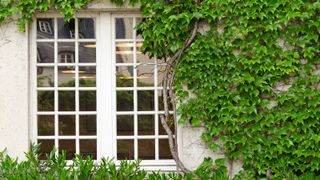5 plants that can damage your home — plus what to do if you find them
We reveal five plants that can cause damage to your home, plus offer tips on how to identify and eliminate them

Your home is your pride and joy and you have put so much money into it that the last thing you want is something as innocuous as a plant damaging it.
Many don't realise the dangers that come from plants that are found in gardens and properties up and down the country. While you might think they are harmless, left unchecked they can bring catastrophic results.
We show you which plants you should look out for, what damage they can do, and if you find any of these species near your home, guide you through how you should deal with them. From tips onJapanese knotweed removalto advice on how to remove a plant's roots, there are methods for dealing with these troublesome plants.
Look out for these plants that can damage your home
From bamboo to Japanese knotweed, there are several plants you'll want to keep a close eye on if you have them in your garden or near your home.
Knowing what to spot is key to stopping any problems before they have chance to develop.
1. Japanese knotweed
Predictably, at the top of the list is perhaps the most well-known of the knotweed species: Japanese knotweed.
Japanese knotweed is an extremely fast-growing and invasive plant, which if left to its own devices, will find its way into weak spots in your home's structure, cause damage to hard surfaces, such as patios and pathways, block drains and even make existing cracks in brickwork worse.
A common confusion can be when it comes to telling whether you have found旋花类或虎杖— but the two are actually very different.

The best way toidentify Japanese knotweedis through its:
- Reddish shoots (they look a little like asparagus) that make an appearance in the spring
- Shovel/shield-shaped green leaves
- Stems that resemble bamboo but that have a speckled green and dark mauve colour
- Frothy clusters of small cream flowers that come out in late summer
As well as damaging your home you could befined £5,000 or be imprisoned for Japanese knotweedif you do not deal with it with expert help, so getting rid of it must be a priority if you find any on your property.
2. English ivy
The common English ivy can cause a number of problems to homes, despite it growing up many of our walls.
English ivy can cause problems like lifting roof tiles and damaging gutters. These plants climb using roots that can sneak into cracks in your walls. They can grow as tall as 50 feet and cover surfaces like bricks and wood.
Some other climbing plants like Boston ivy and Virginia creeper, which look similar, won't harm your property in the same way. So if you're not sure whether you have English ivy it's best to talk to an expert, such as a property surveyor.

You should though be able to identify English ivy though from its distinguishable heart-shaped, waxy, and pointy leaves, the dark berries it grows in spring and summer and their stems which can get 10 inches thick and have a bumpy texture.
如果你或e removing ivy from your home, be careful not to disturb any nesting birds as it's against the law to damage or destroy bird nests that are being used.
You can pull ivy off by hand, but make sure to kill the roots in your walls and on the ground. Using a simple weed-killing spray should do the trick.
3. Horsetail
Horsetail (Equisetum Arvense) is a native perennial weed with roots that go two metres below the surface which can present problems to your home's structure.
This plant appears in driveways and footpaths and can spread quickly towards your property and affect its foundations.

You can identify Horsetails by their light green shoots during summer and autumn, transitioning to brown in spring, and by its shoots resembling fir trees with folded needle-like leaves that feel rough to the touch because of their natural hard covering.
在春天,植物发展体结构cture at the stem's tip, capable of producing over 100,000 spores. The plant can also grow as tall as 60cm.
Although the plant does not survive through winter you shouldn't wait to gain professional help in removing the plant, which requires digging out. Its deep rooted structure makes complete removal very challenging, which is why seeking expert assistance is recommended.
4. Bamboo
As the fastest-growing plant in the world, with some growing up to a metre a day, bamboo can cause serious problems to your home.
Some types of bamboo can spread extensively underground, reaching up to 30 feet deep and potentially causing conflicts with neighbours if they cross property lines. They can squeeze through cracks in concrete and even push through bricks, drains, cavity walls and patios, similar to Japanese Knotweed.
There are two main kinds of bamboo: clumping and running. The running type can prove more troublesome because it spreads quickly. Bamboo is recognised by its thick stems, called culms, and the places where these stems connect.

Bamboo is hard to control and can't be killed with weed killers. The recommended way to get rid of it is the energy depletion method. This involves cutting down the stems to the ground before new leaves appear and repeating this for many years. The goal is to use up the plant's stored energy in its root system.
If you want an easier solution, you can hire a professional to remove the bamboo. However, this can be expensive, with quotes going as high as £1,750.
5. Trees
Despite them being common throughout the country trees can actually prove hazardous to your home for a number of reasons.
Most trees won't cause any problems, but many native species, such as oak, willow, and poplar, can cause problems like making the ground sink, damaging structures, and clogging drains.
Also, just like Japanese knotweed, the roots of these trees can get into cracks in concrete and even affect how the land is used. Older buildings with shallow foundations, built before the 1950s and up to four storeys tall, are most at risk of sinking due to tree roots.

During spring and summer, trees can dry out the soil nearby, which might lead to the ground shrinking and sinking. If the trees are close to your home and the sinking continues for a prolonged period of time, it can cause problems. In very serious cases, expensive underpinning could be required.
Large trees that are a good distance away from your property are likely safe and won't harm your home. Still, it's a good idea to get advice from a professional if you think they could be causing problems for your home.
Here's how to identify oak, willow, and poplar trees:
- Oak trees have lobed leaves, usually symmetrical, and produce acorns. They're quite tall, up to 21 meters, and have a thick trunk and scaly bark.
- Willow trees often grow near water and have long, narrow leaves that are around 5 to 15 centimetres long.
- Poplar trees come in over 25 species and grow in various ways. The common cottonwood poplar is tall and thin, often forming hedges. It can reach 100 feet in height with a thick trunk and somewhat weak and uneven branches.
Getting rid of trees should be a last resort, but if the tree is dying for example, it may be your only option.
It's always best to consult a tree surgeon or specialist who will advise on the best course of action. If they do need to cut it down, it can typically cost around £1,000 to £3,000 (depending on the tree's overall size). If you're unsure whether your tree might be a problem, a property expert can usually spot any concerns during a house survey.
Get the Homebuilding & Renovating Newsletter
Bring your dream home to life with expert advice, how-to guides and design inspiration, direct to your inbox.

News Editor Joseph has previously written for Today’s Media and Chambers & Partners, focusing on news for conveyancers and industry professionals. Joseph has just started his own self build project, building his own home on his family’s farm with planning permission for a timber frame, three-bedroom house in a one-acre field. The foundation work has already begun and he hopes to have the home built in the next year. Prior to this he renovated his family's home as well as doing several DIY projects, including installing a shower, building sheds, and livestock fences and shelters for the farm’s animals. Outside of homebuilding, Joseph loves rugby and has written for Rugby World, the world’s largest rugby magazine.
Most Popular
Bring your dream home to life with expert advice, how-to guides and design inspiration, direct to your inbox.
Thank you for signing up to Homebuilding. You will receive a verification email shortly.
There was a problem. Please refresh the page and try again.
